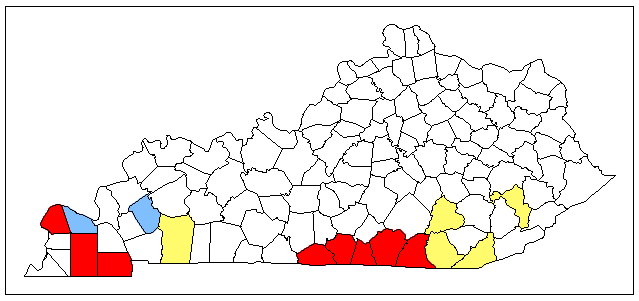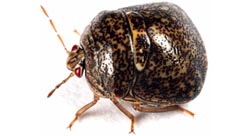Kudzu Bug in Kentucky
Kudzu Bug in Kentucky: Updates and Information
This page contains information about the Kudzu Bug (Megacopta cribraria ) in Kentucky. The insect was first found in Bell, Christian, Laurel, Perry, and Whitley Counties (yellow) in 2015. It was discovered in Ballard, Calloway, Clinton, Cumberland, Graves, McCreary, Monroe, and Wayne in 2016 (red). Lyon and McCracken counties (blue) joined the list in 2017. If you suspect that it is present in a county not marked on the map, please take a sample to your County Cooperative Extension office or send it to the UK Department of Entomology, S-225 Ag Science North, Lexington, KY 40546-0091. Follow this link for more information about this insect and the most recent national distribution map.


Kudzu Bug Adult: picture from Pioneer Soybean insect and disease guide - https://www.pioneer.com/home/site/us/agronomy/crop-management/soybean-in...
Adult Kudzu bugs are almost square, approximately ¼ inch long, dark brown insects with olive green speckles. These insects have sucking mouthparts which they use to feed on plant sap.
Potential Impact in Kentucky
- Plant pest - The Kudzu bug has quickly become a significant pest of soybean and other legume crops in the southeast. Researchers at the University of Georgia have shown an average yield loss of 18% yield loss (maximum 47% ) in sprayed vs.unsprayed soybeans. This native of Asia lives in latitudes comparable to Kentucky so there is no reason to believe that it will not do well in the Bluegrass state. Learn more about the Kudzu bug in Kentucky soybeans in ENTfact 154.
- Fall Accidental Invader - Kudzu bug will cause the same tyeps of problems seen with the multicolored Asian lady beetle and the brown marmorated stink bug. Adults are attracted to homes and structures in the fall as they seek shelter to survive the winter. They are particularly attracted to white surfaces. These small insects can enter through cracks and crevices. When present in large numbers, they may soil the exterior of the home and produce an unpleasant smell.
Management of the Kudzu bug indoors
In The Home: Mechanical exclusion is the best method to keep stink bugs from entering. Seal cracks around windows, doors, siding, utility pipes, behind chimneys, and underneath the wood fascia and other openings with good quality silicone or silicone-latex caulk. Repair or replace damaged screens on doors and windows.
Exterior applications of insecticides, may offer some minor relief from infestations where the task of completely sealing the exterior is difficult or impossible. Homeowner products containing the active ingredients deltamethrin, cyfluthrin, lambda-cyhalothrin, cypermethrin, or permethrin are options. They should be applied in the fall to exterior surfaces as the bugs begin to congregate. These insecticides are broken down by sunlight so the residual effect will decrease after a few days or a week.
If many bugs are entering the living areas of the home, attempt to locate and seal the openings. Kudzu bugs will emerge from cracks under or behind baseboards, around window and door trim, and around exhaust fans or lights in ceilings. Both live and dead stink bugs can be removed from interior areas with the aid of a vacuum cleaner. However, the vacuum may acquire the smell of stink bugs for a period of time.
It is not advisable to use an insecticide inside after the insects have gained access to the wall voids or attic areas. Although insecticidal dust treatments to these voids may kill hundreds of bugs, there is the possibility that scavenger insects, such as carpet beetles, will feed on the dead stink bugs and subsequently attack woolens, stored dry goods or other natural products in the home. Although aerosol-type pyrethrum foggers will kill stink bugs that have amassed on ceilings and walls in living areas, they will not prevent more from emerging shortly after the room is aerated. For this reason, use of these materials is not considered a good solution to long-term management of the problem. Spraying insecticides into cracks and crevices will not prevent the bugs from emerging and is not a viable or recommended treatment. More suggestions are available in How to Pest Proof Your Home. Entfact -641.
Brief History in US
Kudzu bug was first detected in the US in the Atlanta, GA metropolitan area in 2009. This pest originated in Asia and was likely transported to the US in international commerce. It is the only member of the true bug family Plataspidae in the Americas. The first detection resulted from homeowners contacting pest control operators for relief from the "new bug" trying to gain entry into their homes. Since that time Kudzu bug has spread across the southeastern states probably by "hitchhiking" on vehicles moving through the infested areas. It is not a regulated pest so there is no quarantine program to limit its movement.
(Prepared by Dr. Douglas Johnson, Extension Entomologist using information modified from kudzubug.org)
